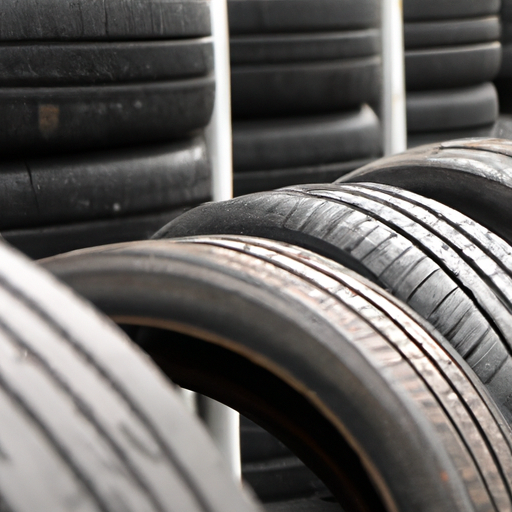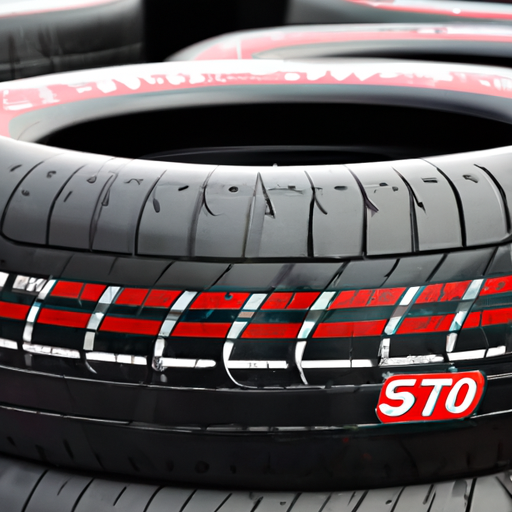If you’re wondering how to properly store spare car wheels and tires, look no further. When it comes to preserving the lifespan and performance of your tires, proper storage is crucial. From choosing the right location to preparing your tires for storage, this article will provide you with all the essential tips and tricks to ensure that your spare wheels and tires remain in top condition when you need them most. So, let’s get started and make sure your precious wheels are in their best shape!

1. Clean the Wheels and Tires
1.1 Remove debris and dirt
Before storing your spare car wheels and tires, it is essential to clean them thoroughly. Start by removing any debris and dirt that may have accumulated on the surface. Use a stiff brush or a tire cleaning brush to scrub away any stubborn dirt or mud. It is important to remove all loose particles to prevent any potential damage while in storage.
1.2 Clean with mild detergent
After removing the debris, it’s time to give your wheels and tires a good cleaning. Use a mild detergent or wheel cleaner specifically designed for cleaning tires. Apply the cleaner and lather it onto the surface using a brush or sponge. Pay close attention to the sidewalls and the treads of the tires, as these areas tend to trap dirt and grime.
1.3 Rinse thoroughly
Once you have scrubbed the wheels and tires with the detergent, rinse them thoroughly with water. Make sure to remove all traces of the cleaning solution to prevent any chemical residue from affecting the rubber. Use a hose or bucket of water to rinse off the wheels and tires until the water runs clear. It is important to ensure that no soap or residue is left behind, as it could lead to potential damage over time.
2. Inspect for Damage
2.1 Check for punctures or cuts
Before storing your spare car wheels and tires, it is crucial to inspect them for any signs of damage. Check for any punctures, cuts, or tears on the tire surface. If you notice any visible damage, it is important to address it before storing the tires. Punctures or cuts can lead to air leakage while in storage or even compromise the overall integrity of the tire.
2.2 Look for signs of wear
Inspecting the tires for signs of wear is another critical step in storing spare car wheels properly. Check the tread wear indicators on your tires to determine if they have reached the minimum recommended tread depth. If the tires are excessively worn, it may be time for a replacement. Uneven wear patterns could indicate improper alignment or incorrect tire pressure, which should be addressed before storage.
2.3 Examine the tread depth
The tread depth of your tires plays an important role in maintaining traction and stability on the road. It is important to examine the tread depth before storing your spare wheels and tires. Use a tread depth gauge to measure the depth of the tire grooves. If the tread depth falls below the recommended levels, it may be time to replace the tires. Proper tread depth ensures optimal performance and safety when the tires are back in use.
3. Prepare for Storage
3.1 Deflate the tires
Before storing your spare car wheels and tires, it is recommended to deflate them slightly. This step helps to relieve any excess air pressure that may accumulate during storage. Overinflated tires can lead to damage, especially if stored in a confined space. Use a tire pressure gauge to measure the current pressure, and then release some air to bring it slightly below the manufacturer’s recommended levels.
3.2 Remove any balancing weights
If your wheels have balancing weights attached, it is important to remove them before storing the tires. These weights are designed to ensure a smooth ride and prevent vibrations. However, they may not be necessary during storage and can potentially cause damage if they come loose. Carefully pry the weights off using a flathead screwdriver, taking care not to scratch or damage the wheels in the process.
3.3 Place the wheels on a protective surface
To prevent any potential damage to the wheels or tires while in storage, it is important to place them on a protective surface. This can include using a pallet, a piece of cardboard, or a specially designed tire storage rack. Elevating the tires off the ground helps to avoid contact with any moisture or debris that may accumulate on the floor. It also ensures that the tires are stored in a stable position, reducing the risk of any accidental damage.
4. Choose a Suitable Storage Location
4.1 Find a cool and dry area
When storing spare car wheels and tires, it is important to choose a suitable location that is cool and dry. Excessive heat and humidity can potentially damage the rubber, leading to sidewall cracking or premature deterioration. Optimal storage conditions include areas such as a basement, garage, or a storage unit with climate control. Avoid storing the tires in areas prone to extreme temperature fluctuations, such as attics or sheds.
4.2 Avoid direct sunlight
Direct sunlight can have detrimental effects on the rubber compounds of the tires. UV rays can accelerate the aging process and cause the rubber to become brittle or crack. It is important to choose a storage location that is shielded from direct sunlight. If storing the tires in a garage or similar location, place them away from windows or cover them with a light-blocking material, such as a tarp or an old blanket.
4.3 Consider using a tire rack
A tire rack is a practical solution for storing spare car wheels and tires. It helps to maximize space while keeping the tires upright and organized. Tire racks are available in various sizes and configurations, allowing for easy access and efficient storage. When using a tire rack, make sure it is sturdy and securely anchored to prevent any incidents. Properly placing the tires on the rack minimizes the risk of distortion or damage.

5. Store in an Upright Position
5.1 Stack the wheels vertically
When storing spare car wheels and tires, it is best to store them in an upright position. This helps to prevent deformation and uneven weight distribution, which can occur if they are stacked horizontally. Stacking the wheels vertically also allows for proper air circulation around the tires, reducing the risk of moisture buildup or mildew.
5.2 Use spacers between the wheels
To ensure adequate airflow and prevent direct contact between the tires, consider using spacers when stacking the wheels vertically. Spacers can be made of sturdy cardboard, wood, or specially designed tire stacking aids. These spacers help to maintain the proper alignment of the wheels and tires, reducing the risk of distortion or damage while in storage.
5.3 Rotate the wheels periodically
To prevent flat spots from forming on the tires over long periods of storage, it is recommended to rotate the wheels periodically. This involves swapping the position of each tire, so they are not bearing the weight in the same spot for extended periods. Aim to rotate the wheels every couple of months to distribute the weight evenly. This practice helps to maintain the tire’s overall integrity and reduces the risk of developing a flat spot.
6. Avoid Damaging Conditions
6.1 Shield from extreme temperatures
Extreme temperatures can have a detrimental effect on spare car wheels and tires. High heat can cause the rubber to deteriorate, while extreme cold can lead to contraction and potential cracking. It is essential to shield the tires from these damaging conditions by storing them in a location that maintains a consistent temperature. An ideal storage temperature is around 65 to 75 degrees Fahrenheit.
6.2 Protect from moisture and humidity
Moisture and humidity can lead to corrosion, mold growth, or deterioration of the rubber components of tires. It is crucial to protect the spare car wheels and tires from these damaging elements. Choose a storage location that is dry and well-ventilated. If necessary, use moisture-absorbing products or consider investing in a dehumidifier to maintain optimal conditions.
6.3 Prevent exposure to chemicals or solvents
When storing spare car wheels and tires, it is important to keep them away from any chemicals or solvents that may come into contact with the rubber. These substances can cause the rubber to break down or become discolored. Store the tires separately from any potentially harmful substances, such as cleaning agents, paint thinners, or fuels. Ensure that the storage area is well-sealed to minimize the risk of fumes or leakage.

7. Cover the Wheels and Tires
7.1 Use high-quality wheel covers
To provide an extra layer of protection for your spare car wheels, consider using high-quality wheel covers. These covers shield the wheels from dust, dirt, and potential scratches. Opt for covers made from durable and breathable materials that allow for proper airflow. Ensure that the covers fit snugly over the wheels to provide maximum coverage and protection.
7.2 Consider using tire bags or plastic wrap
For added protection, you can also consider using tire bags or plastic wrap to cover the entire tire. This extra layer helps to shield the rubber from exposure to light, moisture, and potential contaminants. Place each tire inside an individual tire bag or wrap it tightly with plastic wrap, ensuring that there are no gaps or openings. This additional barrier adds an extra level of defense against potential damage.
7.3 Ensure a snug fit
Whichever method of covering you choose, it is important to ensure a snug fit. Loose covers can allow dust or moisture to penetrate, defeating the purpose of protection. Make sure the covers are securely fastened and properly sealed to provide maximum coverage. Regularly check the condition of the covers and replace any that show signs of wear or damage.
8. Maintain Proper Tire Pressure
8.1 Check the tire pressure regularly
To keep your spare car wheels and tires in optimal condition during storage, it is important to check the tire pressure regularly. Tire pressure can decrease over time, especially when stored for long periods. Use a tire pressure gauge to measure the pressure and ensure it is within the recommended range. If needed, inflate the tire to the proper pressure.
8.2 Inflate to the recommended level
When inflating the spare car tires, refer to the manufacturer’s recommended inflation levels. Overinflation can lead to damage during storage, while underinflation can cause the tires to develop flat spots. Properly inflating the tires to the recommended levels ensures that they are appropriately supported and minimizes the risk of potential damage.
8.3 Release pressure if needed
If you plan to store the spare car wheels and tires for an extended period, it may be beneficial to release some air pressure. This practice helps to prevent excessive strain on the rubber and reduces the risk of any damage during storage. However, it is important to strike the right balance and avoid releasing too much pressure, as the tires still need some inflation to maintain their shape.

9. Inspect and Rotate the Tires
9.1 Check for any changes in tire condition
During the storage period, it is recommended to periodically inspect the spare car wheels and tires for any changes in their condition. Look for signs of cracking, dry rot, or any other forms of damage. If you notice any significant changes, it is important to address them promptly. This includes adjusting the storage conditions, investing in repairs, or even considering tire replacement if necessary.
9.2 Rotate the tires every 6 months
To ensure that the spare car wheels and tires wear evenly, it is advisable to rotate them every six months while in storage. This practice helps to distribute the weight and minimizes the risk of developing flat spots or uneven wear patterns. Following a regular rotation schedule maintains the tire’s overall integrity and ensures optimal performance when they are back in use.
9.3 Follow the manufacturer’s recommendations
When it comes to storing spare car wheels and tires, it is always best to consult the manufacturer’s recommendations. Different tire brands or models may have specific guidelines for storage and maintenance. These guidelines may include details on proper inflation levels, rotation intervals, or storage temperature. By following the manufacturer’s recommendations, you can ensure that your spare wheels and tires are stored in the best possible manner.
10. Reinstall the Wheels and Tires
10.1 Inflate the tires to the proper pressure
Before reinstalling your spare car wheels and tires, ensure that they are properly inflated. Use a tire pressure gauge to measure the pressure and inflate them to the recommended levels. Refer to the manufacturer’s guidelines or the information on the sidewall of the tire for the appropriate inflation range.
10.2 Ensure even tightening of lug nuts
When reinstalling the wheels, ensure that the lug nuts are tightened evenly and securely. Use a torque wrench to achieve the recommended torque specification for your specific vehicle. Tightening the lug nuts in a star or cross pattern helps to ensure even distribution of the clamping force, reducing the risk of wheel imbalance or damage.
10.3 Test the vehicle for proper functionality
Once the spare car wheels and tires are reinstalled, it is important to test the vehicle for proper functionality. Check for any vibrations or wobbling that may indicate an issue with the installation. Take the vehicle for a short test drive to ensure that the tires are performing as expected and that there are no unusual noises or handling problems. If any concerns arise, consult a professional mechanic for further assistance.
Properly storing spare car wheels and tires is vital to maintaining their condition and ensuring their longevity. By following these comprehensive guidelines, you can protect your investment and be confident that your spare wheels and tires will be in optimal condition when you need them. Remember to clean, inspect, and prepare the wheels and tires before storing them, choose a suitable location, use protective measures, and regularly maintain proper tire pressure. With proper care and attention, your spare car wheels and tires will be ready to hit the road when you need them most.


